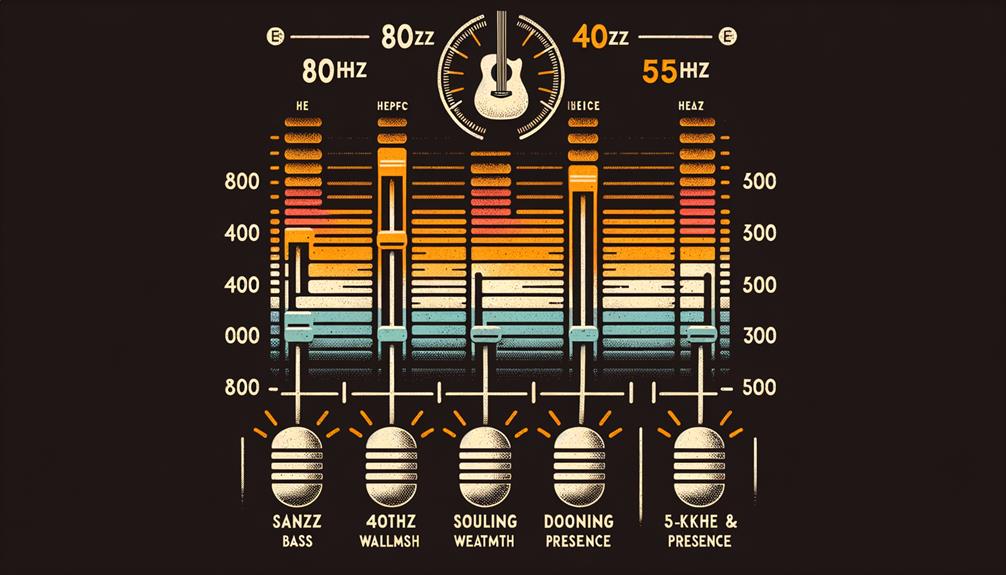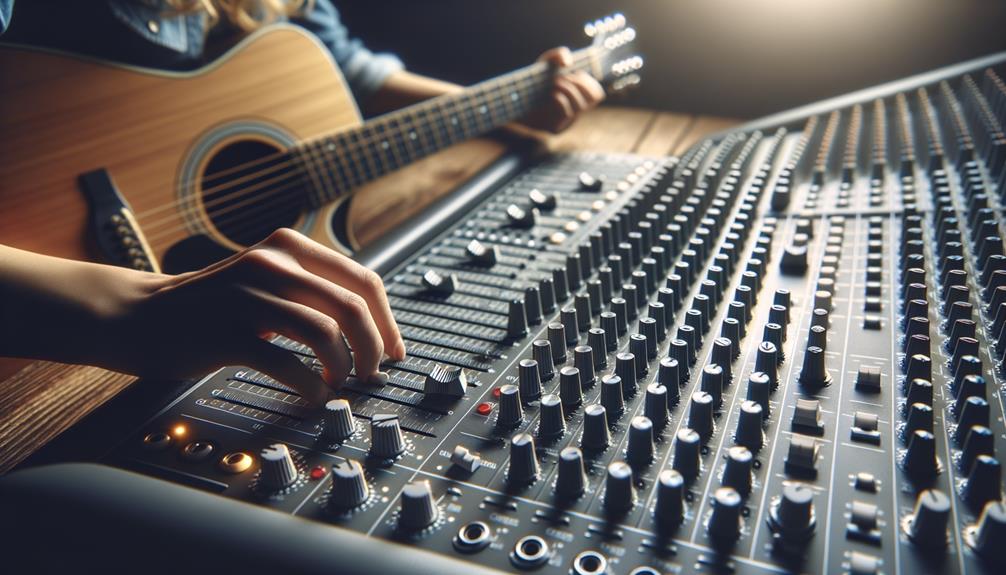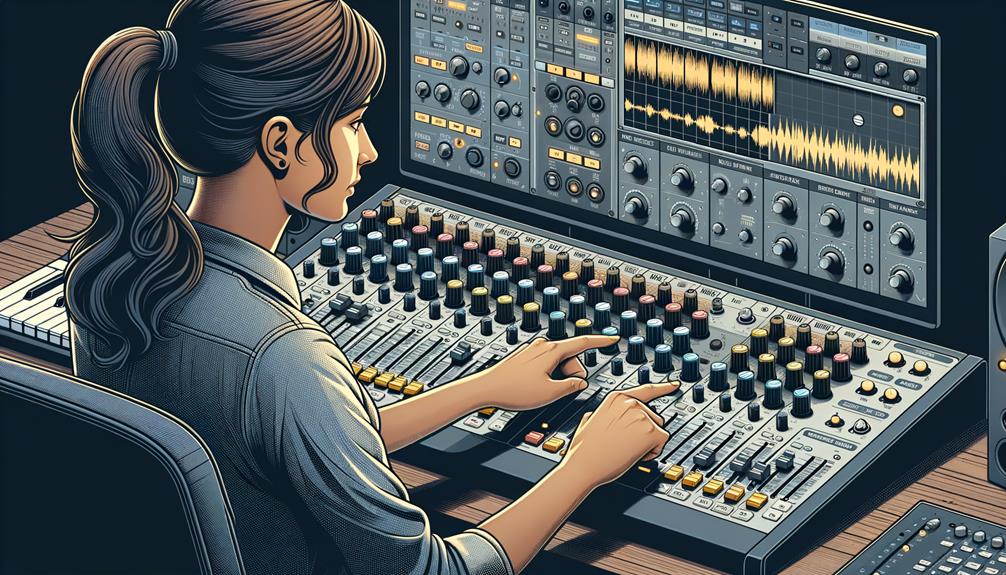No products in the cart.
When EQing a guitar, you want to carve out its own sonic space and ensure that all elements of the mix are clear and balanced. Understanding the basics of guitar EQ is crucial in achieving this.
It involves more than just turning knobs – it’s about identifying specific frequencies that need adjustment and using various filters to sculpt the guitar’s tone.
By mastering these techniques, you can transform the sound of your guitar and ultimately elevate the quality of your music.
Contents
hide
Key Takeaways
- Understanding the impact of different frequencies is crucial in guitar EQ.
- High and low-pass filters can be used to remove unwanted frequencies.
- Fine-tuning EQ frequencies can shape the guitar’s sonic characteristics.
- Enhancing guitar tone with EQ involves boosting or cutting specific frequencies.
Understanding Guitar EQ Basics
Understanding Guitar EQ Basics involves not only adjusting audio frequencies, but also utilizing various EQ filters to control and shape the guitar’s frequency content, ultimately enhancing its sound. When dealing with guitar EQ, it’s crucial to comprehend the frequency range and the impact of different frequencies on the overall tone.
The low frequencies, for instance, contribute to the warmth and fullness of the sound, while the high frequencies add brightness and clarity. In the mixing process, understanding these frequency ranges enables you to sculpt the guitar’s tone to fit perfectly within the mix.
EQing a guitar involves manipulating specific frequency bands to enhance its sonic characteristics. By using EQ filters such as high pass, low pass, bell, notch, and others, you can effectively remove unwanted frequencies and emphasize the desired ones.
For electric guitars, mastering EQ techniques like dynamic EQ and mid/side processing can help troubleshoot and enhance the guitar’s tone, ensuring that it stands out in the mix.
Innovative EQ practices, such as additive EQ techniques involving bell and shelf EQ, can be employed to add warmth, presence, brightness, and air to guitar tones, enriching the sound of both electric and acoustic guitars.
Mastering these EQ basics opens up a world of possibilities for shaping and enhancing the guitar’s frequency content, ultimately leading to a more refined and impactful sound.
Using High and Low-Pass Filters
To sculpt the guitar’s frequency content and further enhance its sonic characteristics, you can employ high and low-pass filters to effectively remove unwanted frequencies and emphasize desired ones.
When EQing electric guitar tone, a high pass filter is a valuable tool for cutting out low-end rumble and unwanted low frequencies that can muddy the sound. By setting the high pass filter at an appropriate frequency, you can clean up the mix and create a more defined, focused low end.
Conversely, a low pass filter can be used to tame excessive brightness and remove unwanted high-end frequencies, providing a smoother, more balanced sound.
Utilizing high shelf and low shelf EQ, you can boost the high end for added sparkle and air, or enhance the low end for warmth and depth, respectively.
Additionally, employing parametric EQ, bell filters, and notch filters allows for fine-tuning the guitar’s frequency ranges, removing unwanted resonances, and enhancing specific frequency bands for clarity and precision.
Experimenting with high and low-pass filters, along with other EQ techniques, can greatly contribute to shaping the unique character of the electric guitar’s sonic profile.
Fine-Tuning Guitar EQ Frequencies

By carefully pinpointing specific frequency bands, you can enhance the guitar’s sound and achieve a more refined sonic profile. When fine-tuning guitar EQ frequencies, it’s crucial to employ a strategic approach to shape the instrument’s sonic characteristics. Here’s a breakdown of how to precisely adjust the guitar’s EQ using various filters and techniques:
| Filter Type | Function |
|---|---|
| High Pass Filter | Eliminates unwanted low frequencies from the guitar, cleaning up the mix. |
| Low Pass Filter | Removes excessive high frequencies, contributing to a more balanced sound. |
| High Shelf EQ | Adjusts the high end of the frequency spectrum, enhancing brightness and clarity. |
| Low Shelf EQ | Shapes the low end of the frequency range, adding depth and warmth to the sound. |
| Bell Filters | Fine-tunes specific frequencies, providing clarity and presence in the mix. |
| Notch Filters | Subtracts problematic frequencies, addressing any resonant or harsh tones. |
Enhancing Guitar Tone With EQ
Enhance the guitar’s tone using EQ by strategically adjusting specific frequency bands to achieve a refined and balanced sonic profile.
When working with electric guitar tracks, consider boosting the presence frequencies around 5 kHz to 7 kHz to add articulation and clarity.
For acoustic guitar sounds, focus on enhancing the high-frequency content to bring out the instrument’s natural brightness and resonance.
Use EQ to cut any unwanted frequencies that muddy the sound, such as low-end rumble or harsh high-end frequencies.
Experiment with bell filters to fine-tune the EQ, emphasizing the sweet spots of the guitar’s tonal characteristics.
Additionally, utilize high shelf and low shelf EQ to adjust the low and high ends of the guitars, adding warmth or brightness as needed.
By carefully sculpting the frequency content, you can bring out the best qualities of the guitar, creating a more dynamic and captivating sound.
Finalizing the Guitar Mix


When finalizing the guitar mix, trust your ears to eliminate unwanted frequencies and bring the guitars to life, creating space for other elements in the overall mix.
To achieve the best EQ for your electric guitars, consider the following:
- Precision EQing: Use surgical EQ techniques to pinpoint and remove problematic frequencies, allowing the clean electric guitar sound to shine through. Boost or cut specific frequency bands to enhance the guitar’s clarity and presence, ensuring it complements the mix without overpowering other elements.
- Contextual Listening: Pay attention to how the guitars interact with other instruments in the mix, such as the snare drum. Adjust the EQ settings to carve out a sonic niche for the guitars while maintaining a cohesive and balanced sound across the entire mix.
- Utilize Specialized Tools: Consider utilizing specialized software like iZotope’s Music Production Suite, offering tailored EQ, compression, and mixing tools designed specifically for guitar production. These tools can enhance the finalizing process, elevating the electric guitar frequency spectrum and overall mix quality.
Frequently Asked Questions
How Do You Use a Guitar Equalizer?
To use a guitar equalizer, adjust the EQ settings on your guitar amp or pedals to sculpt the guitar sound. Experiment with EQ techniques to enhance guitar tone, manipulate guitar frequencies, and make precise EQ adjustments using the EQ knobs.
How Do I Boost My Guitar in Eq?
To boost your guitar in EQ, focus on shaping your guitar tone by adjusting specific EQ settings. Enhance the sound by boosting frequency ranges that complement your guitar’s tone control, ultimately creating a more dynamic and powerful guitar sound in your audio mixing and music production.
What Is the Frequency of the Electric Guitar Eq?
The frequency range of an electric guitar EQ spans from 80Hz to 4.5kHz, shaping guitar tones and instrumental resonance. EQ settings target specific frequencies for sound shaping, tone control, and audio manipulation, refining the frequency response through signal processing.
What Does EQ Do on a Guitar Amp?
EQ on a guitar amp adjusts the frequency response, shaping your guitar tone and enhancing the sound. It allows you to make precise audio adjustments, manipulate the signal, and customize your guitar settings for optimal tone shaping and sound enhancement.
Conclusion
Now that you’ve mastered the art of EQing your guitar, you can take your mixes to the next level.
By understanding the basics of guitar EQ, using high and low-pass filters, fine-tuning frequencies, and enhancing tone, you can create a polished and professional sound.
With these techniques in your arsenal, you’ll be able to craft a guitar mix that stands out and delivers a clear and balanced sonic experience.




